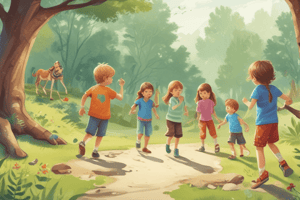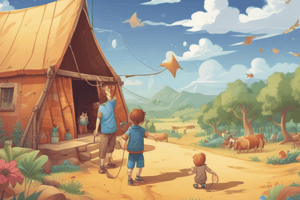Podcast
Questions and Answers
How does Vygotsky's concept of the Zone of Proximal Development (ZPD) relate to a child's learning during play?
How does Vygotsky's concept of the Zone of Proximal Development (ZPD) relate to a child's learning during play?
- Children learn best when playing alone, without needing help from others.
- The ZPD describes the activities children can already do independently.
- Play creates the ZPD, allowing children to perform at a higher level than they could alone, with the assistance of others. (correct)
- The ZPD is irrelevant to play, as play is purely for enjoyment and not for learning.
According to observations, how does social play evolve as children grow?
According to observations, how does social play evolve as children grow?
- Social play remains constant throughout childhood, with no significant changes in complexity.
- Social play is only relevant for toddlers and diminishes as children enter preschool.
- Social play becomes less complex as children mature, focusing on individual activities.
- Social play becomes more complex with age. (correct)
Which type of play is characterized by children using objects or actions to represent other objects or ideas?
Which type of play is characterized by children using objects or actions to represent other objects or ideas?
- Locomotor play
- Symbolic play (correct)
- Physical play
- Functional play
How did John Locke view children in the context of early education?
How did John Locke view children in the context of early education?
What is the role of the supervisor during outdoor play?
What is the role of the supervisor during outdoor play?
According to Piaget, what is the primary distinction between play and cognitive development?
According to Piaget, what is the primary distinction between play and cognitive development?
Which of the following best describes the concept of 'decontextualization' in symbolic play?
Which of the following best describes the concept of 'decontextualization' in symbolic play?
How did Vygotsky's view on the relationship between play and development differ from Piaget's?
How did Vygotsky's view on the relationship between play and development differ from Piaget's?
What is the role of the adult as an 'organizer' in children's play?
What is the role of the adult as an 'organizer' in children's play?
Which of the following reflects a key consideration in designing outdoor play environments specifically for infants and toddlers?
Which of the following reflects a key consideration in designing outdoor play environments specifically for infants and toddlers?
What is meant by the term 'preoperational thinking' in the context of play development for preschoolers?
What is meant by the term 'preoperational thinking' in the context of play development for preschoolers?
Which theorist is known for identifying observable social play behaviors in children?
Which theorist is known for identifying observable social play behaviors in children?
Why is it important for teachers to consider safety when children are engaging in superhero play?
Why is it important for teachers to consider safety when children are engaging in superhero play?
Which of the following is defined as imitation of reality that includes orderliness, exact imitation of reality, and collective symbolism of play of roles?
Which of the following is defined as imitation of reality that includes orderliness, exact imitation of reality, and collective symbolism of play of roles?
How does the concept of 'assimilation' relate to play, according to Piaget?
How does the concept of 'assimilation' relate to play, according to Piaget?
Flashcards
Role of the organizer?
Role of the organizer?
Providing written/verbal instructions, modeling, and organizing materials to achieve goals.
Role of the observer?
Role of the observer?
Observing children's behavior and interactions without interfering, focuses on overlooked responsibilities.
Role of the supervisor?
Role of the supervisor?
Focuses on safety, supervises material usage and playground condition, interacts with children
Role of the evaluator?
Role of the evaluator?
Signup and view all the flashcards
Concerns for outside play?
Concerns for outside play?
Signup and view all the flashcards
Vygotsky's zone of proximal development
Vygotsky's zone of proximal development
Signup and view all the flashcards
Sociocultural view of play
Sociocultural view of play
Signup and view all the flashcards
Montessori's view on observation
Montessori's view on observation
Signup and view all the flashcards
Social Play behaviors
Social Play behaviors
Signup and view all the flashcards
Fine motor skills
Fine motor skills
Signup and view all the flashcards
Gross motor skills
Gross motor skills
Signup and view all the flashcards
Locomotor skills
Locomotor skills
Signup and view all the flashcards
Types of Observation
Types of Observation
Signup and view all the flashcards
Piaget's Stages of Play
Piaget's Stages of Play
Signup and view all the flashcards
Sensorimotor play (Birth to age 2)
Sensorimotor play (Birth to age 2)
Signup and view all the flashcards
Study Notes
- Play development notes have been given
Role of Adults
- The role of the organizer involves written and verbal instructions
- Organizers should model and engage in rehearsal
- Organizers should organize materials with the consideration of needs and goals
- Observers often have overlooked responsibilities
- Observers should observe children's behavior and interactions with other children
- Supervisors focus on safety, how students use materials, and playground upkeep
- Supervisors can walk around the playground, observe behavior, and interact with children
- Supervisors should avoid talking to other adults to prevent distraction from children's behaviors
- Evaluators assess behavior
Outdoor Play Concerns
- Main concerns regarding outside play are injuries, the safety of materials, and the condition of outdoor play things
- An example of an outdoor play concern is: Is the playground safe? Is it rusty? Is the swing loose?
Outdoor Play Environments for Infants and Toddlers
- When designing these enviroments, consider different motor skills, such as space for running and climbing stairs
- Include toys like pretend play items, blocks, sand pits, clay, etc.
- A slide for infants and toddlers doesn't need to be ten feet high
- Outdoor enviroments should be proportionate to size and development
Outdoor Play Environments for Preschoolers and Kindergarten
- Increase the scale compared to infants/toddlers'
- Introduce space for more complex motor skill development, like monkey bars
Outdoor Play Environments for Primary School Age Children
- Increase the scale with more room to run around and play larger organized games
Ways of Play and Benefits
- Vygotsky created the zone of proximal development during play which is a zone that children move from when accomplishing a task or skill with the assistance of each other and being able to complete the task independently
- A sociocultural view of play emphasizes planning for play and language usage during play
- Maria Montessori pioneered the use of observation to inform instruction
- She believed that teachers should observe the child's use of materials to understand the child's level of knowledge and confidence in using the materials
- When a child reaches a sensitive period, they move to the next level or challenge as they try to match their own readiness with the materials that are available
Social Development
- Mildred Parten first identified observable behaviors that reflect social development
- She described social play behaviors of children during outdoor play which becomes more complex with age
- Parten classified social play into six categories:
- Unoccupied behavior
- Onlooker behavior
- Solitary play
- Parallel play
- Associative play
- Cooperative play
Motor Skills
- Fine motor skills involve small muscles, like when cutting
- Gross motor skills involve big muscles, like kicking
- Locomotor skills involve moving, like skipping
Benefits of Outdoor Play
- Outdoor play encourages physical movement and good health
- It creates a unique environment for learning that stimulates brain development
- It encourages different levels of social participation as children self-select playmates
- It develops standards of morality during interactions with peers and more competent peers
- Outdoor play provides opportunities to engage in freely chosen play
Types of Observation
- Class activity includes:
- Checklist
- Rating scale
- Running record
- Anecdotal records
- Event samplings
Understanding Cognitive Development
- Piaget, Vygotsky, and Maria Montessori have influenced how observations are used to understand children
Piagetian-Inspired Stages of Play
- Piaget (1951-1962) described three levels of cognitive development reflected in play behavior
- Play becomes more complex with age
- Stage 1 is sensorimotor play which occurs from birth to age 2
- Stage 2 is symbolic play which occurs from age 2 to 7
- Stage 3 is games with rules which occurs from age 7 to 11
- During the first two years of group 2, stage 1 - sensorimotor play, functional and practice play dominate
- Exploration play occurs through senses which strengthens neurological connection and object play when grasp, where functional vs indiscriminate play are object guided
War Play
- War play involves using weapons and is violent and aggressive
- Swords, guns, etc can be used during war play
- War play is influenced by video games like Call of Duty and Fortnite, and also shows like Teenage Mutant Ninja Turtles, and may be influenced by being raised in a military family
- War play can create confidence, physical activity, moral development, collaboration, and imagination
Video Play Example
- This example features superhero play which is both functional play
- The video had superhero play when the hulk fought another superhero
- He also had collections of action figures
- The actions figures were used as dominoes making them symbolic/ functional play
- This is an example of how complex play occurs, by incorporating media/ what children have seen
Play Development for Preschoolers
- Cognitive development is preoperational thinking which is a period when thought processes have not fully matured
- Egocentric thinking is when everything revolves around them
- Children view the world through their sense/ what they see and believe. Magic is real to them.
Types of Preschool Play
- Symbolic play
- Sociodramatic play
- Physical play
Symbolic Play
- Symbolic play occurs when the child uses an object or action to represent another object or idea
- Dramatic play begins to develop during the second year of life
- As the child matures, the play grows more complex
Dramatic Play
- The view of dramatic play is imitation of reality the includes orderliness, exact imitation of reality, and collective symbolism of play of roles
- Two to three year olds initially direct their play toward materials or objects when engaging in pretend play
- As children mature, they include people and assume different roles
Sociodramatic Play
- Sociodramatic play occurs among two or more children who communicate verbally and then cooperatively adjust their roles during the play episode
Six Characteristics of Sociodramatic Play
- Imitative role-play
- Make-believe with regards to objects
- Verbal make-believe
- Persistence in role play
- Interaction
- Verbal communication
Superhero Play
- Superhero play is a pretend play that may consist of heroes, villains, victims, sidekicks, and superpowers
- This type of play can help to develop social skills in the talking part of roleplaying, gaining a better understanding of right and wrong, and physical incorporating running, jumping, and more movements
- Some teachers may view it as concerning because of its unrealistic views of what somebody can do or may encourage a violent interaction between heroes and villains
- If they engage in superhero play, monitor the safety, risks, and language that is being used
Benefits of Play for Infants and Toddlers
- Cognitive development
- Social development
- Emotions
- Communication
- Physical development
Communication and Emotional Development for Infants and Toddlers
- Through play, babies develop turn-taking and communication signals skills, and start making sense of the their world
- Emotional development is heavily dependent on trust building and attachment
- Communication involves interaction, children practice taking turns and mutual reciprocal interactive play
- The two major factors impacting physical play for infants is gaining teeth and toilet training process
Practice Play for Infants and Toddlers
- The sensorimotor period
- Functional or practice play dominates during the first two years of life
- Practice body movements
- Actions are repeated for practice and exploration
Six Levels of Practice Play
- Reflective stage
- Primary circular reactions
- Secondary circular reactions
- Coordination of secondary schemes
- Tertiary circular reaction
- Inventions of new means through mental combinations
- As children develop their mobility and motor skills, they begin to incorporate more complex schemes into their play
Exploration
- An infant will spend a lot of time exploring the world through her senses
- Looking and listening are most common
- Infants spend most of their time exploring while toddlers split their time between exploration and practice play
Object Play
- Object play begins when the infants can grasp objects
- Occurs around the secondary circular reaction stage
- Object play becomes more complex as the child grows and develops
- Functional play is when a child uses the object for the function that the object was intended in her culture
- Indiscriminate play occurs when the child uses the object in an indiscriminate or stereotypical way
Symbolic Play
- Young children begin to engage in pretend play around their first birthday
- It becomes complex in the second year of life
- Three major elements in symbolic play occurs during the first two years of life:
- Decontextualization occurs when the child represents objects and actions symbolically with other objects and actions
- Decentration occurs when the child moves from focusing on self to focusing on others
- Integration involves the combination of several single schemes into a multiple-scheme play experience: These behaviors are generally observed around the second birthday
- Most of the play involves imitating reality and seems to follow the social conventions for the activity
Lev Vygotsky Theories
- Considers the social, cultural and historical factors that influence cognitive development during social interactions
- Children construct knowledge through interactions with society and culture
- Both piaget and Vygotsky differed greatly in their views of cognitive development
- Children learn during social interactions with an adult or more capable peer
- For Vygotsky, learning occurs in the zone of proximal development (ZPD)
- ZPD is the distance between the point of being capable of doing something with the assistance of others to the point of being capable of accomplishing the task alone
- For Vygotsky, the zone of proximal development is created during play
- During play "The child always behaves beyond his average age, above his daily behavior, in play it as though he were a head taller than himself” (Vygotsky, 1978, p 102)
- Piaget believed that play followed development, Vygotsky believed that development occurred during play because play creates the ZPD
- Essential components:
- Imaginary situation
- Rules and roles are embedded in an imaginary situation
- For Vygotsky, play contributed to the development of language, memory, reasoning, and social skills
Modern vs Postmodern Theories
- More Modern Theories include:
- Arousal Modulation Theory
- Communication Theory
- Cognitive Adaptation Theory
- Theory of Mind
- Postmodern Theorists/ Theories include:
- Brian Sutton-Smith
- Gail Cannella
Theories of Play
- There are many
- Most influential theories of play were developed by Freud, Erickson, Piaget, and Vygotsky
- Classic theories, modern theories and postmodern theories
Early Figures - Play
- John Locke (1632-1704) english philosopher, exiled in France:
- Children are a blank slate and can learn through play when adults use toys to teach concepts
- He created the first wooden alphabet blocks
- Jean-Jacques Rousseau (1712-1778): Children are innately good and nature is a primary force in learning
- Johann Heinrich Pestalozzi (1746-1827): Children should be free to explore and they learn through action (learn by doing)
- Freidrich Froebel (1782-1852):
- He invented kindergarten
- He believed that children learned through play
- He influenced many future theorists
Classic Theory of Play
- Surplus Energy Theory of Play states that children play because they have too much energy and play will rid them of the excess, this was made by Friedrich Van Schiller
- Herbert Spencer was the one who identified this as "surplus energy" theory
Child Study Movement
- John Dewey was an American Educator
- He used play and hand-on learning as a foundation for curriculum
- He rejected Froebel's view of play stating "In play, the activity its own end, instead of having ulterior results.” (1973)
- Patty Smith Hill:
- She questioned Froebel's methods
- Used G. Staley Hall's work to develop an approach called free play
- Created the first hollow blocks
Psychoanalytic Theory
- The Psychoanalytic Theory was developed by Sigmund Freud and then extended by Erik Erickson
- From this perspective, play benefits social and emotional development
- They differed in the area of Erickson's explanation of unconscious motivation in terms of psychosocial – not psychosexual forces
- The work of Freud and Erickson has influenced research on play throughout the twenty century and continues to influence play therapy
- Maria Montessori stated that "Play is the work of the child"
- Montessori was the Founder of Montessori Method of education
- The first House of Children (Casa dei Bambini) opened in 1907
- Developed a theory of teaching that focuses on developing the child's independence and cognitive ability through hands-on activities
- Play in montessori schools is restricted, pretending has no place in Montessori education
Constructivist Theory of Play
- Jean Piaget is famous for creating his theory of cognitive development
- He is well known for his contributions to play theory
- Intellectual adaptation results from the combined opposition of two invariant processes: accommodation and assimilation
- Play provides a relaxed atmosphere in which learning can easily occur
- Play is NOT the same as learning
- Cognitive development requires both assimilation and adaptation, while play is assimilation without accommodation
- Assimilation occurs when the individual fits information into existing mental structures
- Accommodation= occurs when children adjust their schemas or mental structures to accept new knowledge
- He thought the child's intellectual level was reflected in her play, and his stages of play development mirror his stages of cognitive development
- The types of play according to piaget are:
- Practice or functional play
- Dramatic play
- Games with rules
Importance of Play
- Play is universal and has a connection with learning
Through Play Children Learn/Hone
- Social skills
- Cultural understanding
- Prosocial behaviors
- Language and literacy skills
- Cognitive skills/brain development
- Motor skills
- Regulate emotions
What Play Is
- Froebel stated "Play is the highest expression of human development in childhood for it alone is the free expression of what is in a child's soul”
- Individuals engage in an activity for enjoyment and recreation rather than a serious or practical purpose
- Glover stated "Play enables children to build and extend their knowledge and skills as they interact with their environment, with others, and their own”
- Rubin and his peers viewed play as a behavioral disposition, as observable behaviors, and as a context, and they include six factors in the disposition of play
Factors in Dispositions of Play
- Play is pleasurable
- Play is voluntary or freely chosen
- Play is non-literal or symbolic
- Play requires active engagement
- Play is free of external rules
- Play focused on means rather than results
History of Children's Play
- Before children work or help their families in their household
- There was a variation across a period of times with various categories which included: region, socioeconomic status, race /ethnicity, and gender
- Similarities (across contexts):
- Play site
- The material (toys and playthings)
- The playmates
- Tensions between self constructed and adult-structured play
Play Throughout History
- Play in early america (pre 1800s)
- Play in the early nineteenth century
- Play in the late nineteenth century
- Golden age of play
- Commercialization and co=optation of children
Studying That Suits You
Use AI to generate personalized quizzes and flashcards to suit your learning preferences.




